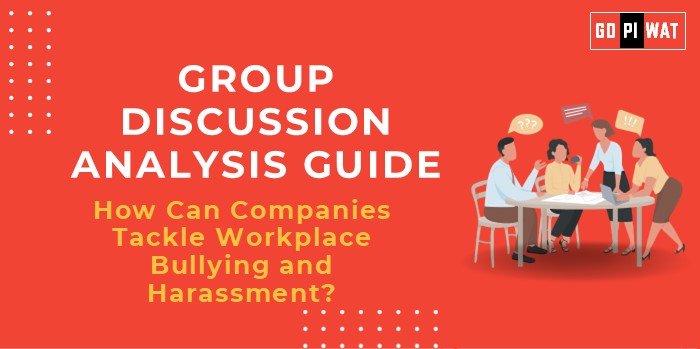📋 Group Discussion (GD) Analysis Guide: How Can Companies Tackle Workplace Bullying and Harassment?
🌐 Introduction to Workplace Bullying and Harassment
- Opening Context: Workplace bullying and harassment are significant challenges across industries, impacting employee well-being, productivity, and organizational reputation. In 2023, over 60% of employees reported experiencing or witnessing workplace harassment globally, showcasing the pervasive nature of the issue.
- Topic Background: These behaviors can range from verbal abuse to subtle psychological intimidation. Various organizations and countries have implemented frameworks, such as the U.S. Equal Employment Opportunity Commission’s (EEOC) anti-harassment policies and India’s PoSH Act of 2013.
📊 Quick Facts and Key Statistics
- 📈 Global Incidence: 60% of employees report bullying or harassment.
- 📉 Economic Cost: Workplace harassment leads to $1.2 trillion in lost productivity annually worldwide.
- 👩💼 Gender Dynamics: Women are twice as likely to face workplace harassment compared to men.
- 🏢 Corporate Responses: Only 45% of companies globally have a formal anti-bullying policy.
👥 Stakeholders and Their Roles
- 👩💼 Employees: Central to reporting and addressing workplace harassment.
- 📋 HR Departments: Key in implementing and monitoring anti-harassment policies.
- 🏢 Leadership Teams: Responsible for fostering a culture of respect and accountability.
- 🏛️ Governments and NGOs: Provide legal frameworks and support systems, such as hotline services and awareness campaigns.
🏆 Achievements and Challenges
✨ Achievements
- Adoption of PoSH laws in India to address sexual harassment.
- Increased awareness campaigns by companies like Deloitte and PwC.
- Development of anonymous reporting platforms like SpeakUp.
⚠️ Challenges
- Reporting Barriers: Fear of retaliation inhibits reporting.
- Cultural Biases: Societal norms often downplay harassment.
- Policy Gaps: Small and medium enterprises (SMEs) lack structured policies.
🌍 Global Comparisons
- Success: Scandinavian countries have some of the lowest rates of workplace harassment due to strong legal frameworks and organizational policies.
- Challenges: In regions like Southeast Asia, underreporting remains a significant issue.
💡 Structured Arguments for Discussion
- Supporting Stance: “Companies with robust anti-harassment policies report 25% higher employee satisfaction rates.”
- Opposing Stance: “Despite policies, harassment remains underreported due to a lack of trust in internal mechanisms.”
- Balanced Perspective: “While companies are advancing their efforts, ensuring systemic change requires a mix of robust policies, training, and cultural shifts.”
🔍 Effective Discussion Approaches
🌟 Opening Approaches
- Start with data: “With over $1.2 trillion lost annually due to workplace bullying, this issue demands immediate attention.”
- Use a case study: “The #MeToo movement highlighted the urgency for workplace reforms globally.”
💬 Counter-Argument Handling
- Example: “While SMEs may lack resources for formal policies, partnerships with NGOs can bridge this gap effectively.”
📈 Strategic Analysis of Strengths and Weaknesses
- Strengths: Awareness and technology-driven solutions like anonymous reporting tools.
- Weaknesses: Limited adoption of frameworks in smaller companies.
- Opportunities: Use of AI in monitoring workplace behavior.
- Threats: Reputational damage due to mishandled harassment claims.
📘 Connecting with B-School Applications
- Real-World Applications:
- Project themes on workplace diversity, ethical leadership, or HR strategy optimization.
- Sample Interview Questions:
- “How can organizations balance profitability with workplace ethics?”
- “What role do leaders play in combating workplace harassment?”
- Insights for B-School Students:
- Recognize the economic impact of workplace bullying.
- Learn to implement effective HR policies during internships.


